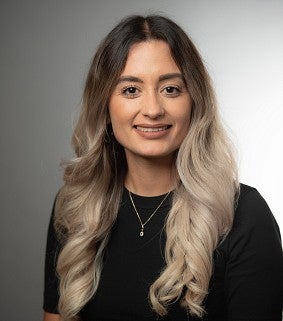
The College of Arts and Sciences is investing in its Latinx studies courses by hiring nine new tenure-track faculty members. The new hires will offer courses to meet the demands of a growing Latinx Studies Minor Program, mentor undergraduate and graduate students, provide fresh perspectives in their disciplines—and more.
Before joining CAS, Isabel García Valdivia’s postdoctoral research at Brown University focused on continuing to study Latinx/e immigrants and their families’ experiences. In addition to teaching, she’s now working on a book manuscript and scholarly articles based on 102 interviews with documented and undocumented older Mexican immigrants, who remain in the US and those who return to Mexico to “retire.”
“Across my solo work, I have used qualitative methods to understand two broad research questions,” says García Valdivia, whose work primarily focuses on Latinx/e communities. “One, how do immigrants’ experiences change across the life course; and two, how does legal status impact families?”

What is your research on?
My research agenda and expertise focus on the intersection between immigration, race and ethnicity, stratification (i.e., race, class, gender, and legal status), social policy, and the sociology of the life course. I investigate how immigrants and their family members, who hold varying legal statuses and racialized identities, live, thrive, and experience integration (or not) in their day-to-day lives, with a particular interest in Latina/e/o/x populations.
I am working on a book manuscript and articles using 102 interviews with documented and undocumented older Mexican immigrants conducted over two years. The book examines how immigration status stratifies the transition to late adulthood among older Mexican immigrants, the largest group of aging immigrants.
In other work, I collaborate with Dr. Kevin Escudero (Brown University) on the Immigration Survey Research Project (ISRP) team. This fall, the ISRP team is conducting a nationwide survey that examines the experiences of immigrant and international graduate and professional degree students navigating the educational pipeline and entering the U.S. workforce.
How do Latinx courses enrich a student’s education?
As a Chicanx/Latinx studies and sociology-trained scholar, I like connecting historical content to current social phenomena, including how Latinx courses enrich students’ education.
We know that the first Chicanx/Latinx programs began in the 1960s and 1970s, stemming from student activism and demands in U.S. colleges and universities. Yet, the institutionalization of these departments/programs (including faculty hiring and resources) has not kept up with the growth of the general Latinx population. Today approximately 64 million Latines/xs (or 19% of the total population) live in the United States—it is the largest racial/ethnic minority. In Oregon, the Latine/x population represents about 14% of the total state population, or almost 600,000 people.
Latinx courses enrich a student’s education because they bring a critical lens to the study of Latine/x communities in the U.S. and abroad as well as race relations more generally.
First, Latine/x studies courses promote the understanding of U.S. Latine/x history, and Latine/x experiences more broadly to all students and learners (independent of own race/ethnicity) since courses take up issues of racism, citizenship, colonialism, borders across disciplines including the social sciences, history, art, etc. All of these issues are important to understanding race relations—especially in the U.S., where racial categories can stratify life outcomes and opportunities.
Second, research suggests that ethnic studies, including Latine/x studies, courses improve student performance and knowledge. Thus, Latine/x courses are important for students to learn the challenges, contributions, and dynamics of the diverse Latine/x experiences.
Third, given that it also has been shown that students of color benefit from learning about their community’s history, Latinx courses also promote student well-being. In addition, Latinx studies courses also fight against the invisibilization of Latinx communities, their histories, and their contributions to the US and abroad.
What was your academic career like? Did you always know you wanted to be in academia? What inspired you to become a professor?
When I started my undergraduate studies at Pomona College [in Southern California], I wanted to become a high school math teacher, so I never thought I would be in academia long-term. Instead, two phenomenal professors—Dr. Gilda L. Ochoa (sociologist) and Dr. Tomás Summers Sandoval (historian)—inspired me to major in sociology and Chicana/o Latina/o Studies and attend graduate school.
When I worked as their research assistant, I learned “what research was” and that it was possible to research issues impacting Latina/e/o/x communities, which I found enjoyable and exciting. They both mentored me closely as an undergraduate student. For example, I will never forget getting an email from Dr. Ochoa – while I was studying abroad – recommending that I apply for the American Sociological Association (ASA) Honors Program to learn more about graduate school and what you could do with a sociology degree.
As a junior, I was accepted to this program and presented a paper on undocumented youth’s college experiences – comparing private and public schools. This was a turning point; I decided to apply to graduate school as a senior in college to continue teaching and researching Latinx immigrant families.
As I begin my first faculty job at UO, I will also serve on the ASA Honors Program Advisory Board for the next two years. It is a full circle.
